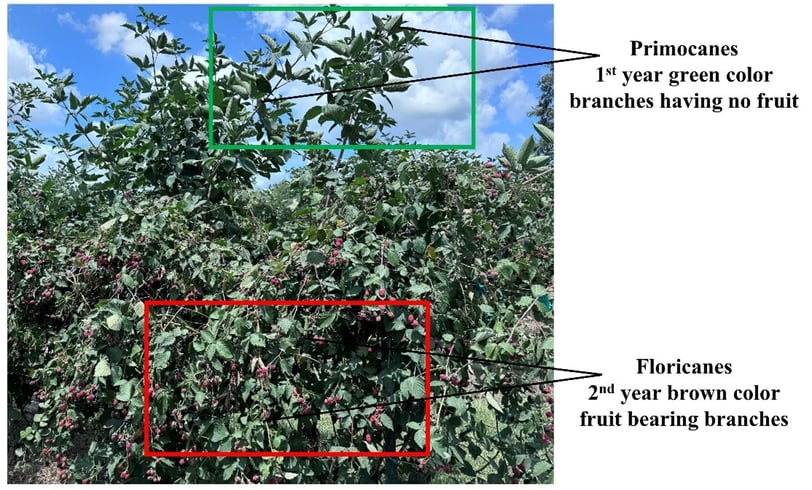Pruning - A Critical Aspect for Optimum Fruit in Blackberry Production
by Muhammad Adnan Shahid & Shahid Iqbal @ University of Florida, Institute of Food and Agricultural Sciences


Blackberry is a significant fruit crop with diverse benefits and uses. Their nutritional value, economic importance, health benefits, and environmental contributions make them an essential fruit in both agricultural and consumer markets. Pruning is a crucial practice in blackberry cultivation, playing a significant role in ensuring healthy plant growth, maximizing fruit yield, and maintaining overall plant vigor. Proper pruning techniques not only enhance the quality and quantity of berries but also help in managing plant diseases and improving harvest efficiency. This article provides a comprehensive overview of blackberry pruning, including an introduction to primocanes and floricanes, the reasons for and timing of pruning, its effects on the plant, and practical recommendations.
Fig 1. Biennial growth cycle of blackberry. The green color branches at the top show primocanes with no fruit, while under the primocanes, brown color branches show floricanes showing fruit bearing.
Introduction to Primocanes and Floricanes
Blackberry plants exhibit a biennial growth cycle, which involves two types of canes: primocanes and floricanes. Primocanes are the first-year canes that grow vigorously during the growing season. They do not produce fruit in their first year but are crucial as they will become the following year's fruit-bearing canes. While floricanes are the second-year shoots, means primocanes transition into floricanes. These canes flowers and bear fruit during the summer. After fruiting, floricanes die off and need to be removed for new growth.
Pruning time, types, and its effect on plant growth
Pruning is a vital practice in plant care, directly impacting plant health, growth, and productivity. Understanding the optimal pruning times, the different types of pruning, and their effects on plant growth can help maximize the benefits of crop production.
In blackberry, late winter to early summer and late summer pruning is done to achieve desired fruit yield. During late winter, while the plants are in dormant condition, pruning is done to remove any dead, damaged, or diseased canes to prevent the spread of disease and improve overall plant structure. This is also the time to thin out overcrowded canes, leaving only 4-6 canes per plant to adequate air circulation and sunlight penetration. In early and late summer pruning, typically when primocanes reach about 3-4 feet in height, their tips are pinched off to encourage lateral branching. This process promotes the development of more fruiting for the next growing season. This dual approach to pruning ensures that blackberry plants remain healthy, with increased air circulation and sunlight penetration, leading to higher yields and better-quality fruit.
Recommendations
Familiarize yourself with primocanes (first-year canes) and floricanes (second-year canes) to effectively manage their growth and fruiting.
Pruning at the right time (winter or summer pruning) and using clean, sharp, and disinfectant shears to remove dead and diseased canes.
Thin out the overcrowded canes for proper light penetration and air circulation
Pinch off the tips of primocanes when they reach 3-4 feet in height during late spring or early summer to promote lateral branching and future fruit production.
Develop a consistent pruning routine to ensure that plants remain healthy and productive throughout their growth cycle.
